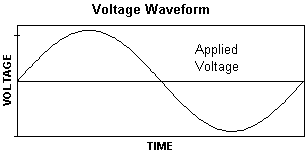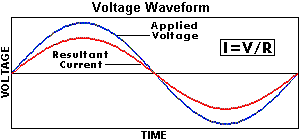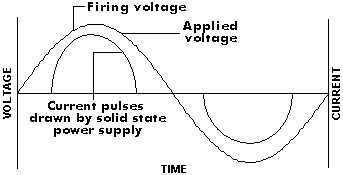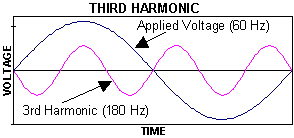As we connect more electronic devices to our power systems, the “quality” of the power becomes more important. “Quality” can be defined many ways. Stable voltages and undistorted waveforms are two characteristics which are very desirable in power systems. Grounding affects voltage stability, and more importantly, is critical to personal safety. Harmonics are a mathematical model we use to analyze distorted waveforms.
You have probably heard the term “harmonics.” Numerous technical articles have been written on this subject; however, these articles do not always address our basic problems in an understandable way:
- What are harmonics?
- How do they affect my building or my product?
- What are the symptoms of harmonics?
- How do I address these systems?
- How do I solve the problem?
Harmonics are a mathematical model of the real world. Harmonics are simply a technique to analyze the current drawn by computers, electronic ballasts, variable frequency drives and other equipment which have modem "transformer-less" power supplies. Let’s examine how these power supplies operate.
There is a law in electrical engineering called Ohm’s Law. This basic law states that when a voltage is applied across a resistance, current will flow. This is how all electrical equipment operates. In the United States, the voltage we apply across our equipment is a sinewave which operates 60 Hertz (cycles per second).

The utilities do a wonderful job of generating this voltage sinewave. It has (relatively) constant amplitude and constant frequency.
Once this voltage is applied to a device, Ohm’s Law kicks in. Ohm’s Law states that current equals voltage divided by resistance. Expressed mathematically:
I=V/R
Expressed graphically, the current ends up being another sinewave, since the resistance is a constant number. Ohm’s Law dictates that the frequency of the current wave is also 60 Hertz. In the real world, this is true; although the two sinewaves may not align perfectly (as a power factor – another topic!) the current wave will indeed be a 60 Hertz sinewave.

Since an applied voltage sinewave will cause a sinusoidal current to be drawn, systems which exhibit this behavior are called linear systems. Incandescent lamps, heaters and, to a great extent, motors are linear systems.
Some of our modem equipment, however does not fit this category. Computers, variable frequency drives, electronic ballasts and uninterruptable power supply systems are non-linear systems. In these systems, the resistance is not a constant and in fact, varies during each sinewave. This occurs because the resistance of the device is not a constant. The resistance in fact, changes during each sinewave.
The “front end” or power supply of these systems contain solid state devices such as power transistors, Thyristors or silicon controlled rectifiers (SCRs). These devices draw current in pulses. Let’s see how they work:
Non-Linear System – Computers,VFDS,Electronics Ballasts
Examine Figure 3. As we apply a voltage to a solid state power supply, the current drawn is (approximately) zero until a critical “firing voltage” is reached on the sinewave. At this firing voltage, the transistor (or other device) gates or allows current to be conducted. This current typically increases over time until the peak of the sinewave and decreases until the critical firing voltage is reached on the “downward side” of the sinewave. The device then shuts off and current goes to zero. The same thing occurs on the negative side of the sinewave with a second negative pulse of current being drawn. The current drawn then is a series of positive and negative pulses, and not the sinewave drawn by linear systems. Some systems have different shaped waveforms such as square waves. These types of systems are often called non-linear systems. The power supplies which draw this type of current are called switched mode power supplies. Once these pulse currents are formed, we have a difficult time analyzing their effect. Power engineers are taught to analyze the effects of sinewaves on power systems. Analyzing the effects of these pulses is much more difficult.

In order to solve this problem we turn to mathematics; specifically, Fourier Analysis. Simply stated, using Fourier Analysis we can prove:
Any periodic waveform can be expressed as a series of sinewaves with varying frequencies and amplitudes.That is, we can create a series of sinewaves of varying frequencies and amplitudes to mathematically model this series of pulses. the frequencies we use are multiples of the fundamental frequency, 60 Hertz. We call these multiple frequencies harmonics. The second harmonic is two times 60 Hertz, or 120 Hertz. The third harmonic is 180 Hertz and so on. In our three phase power systems, the “even” harmonics (second, fourth, sixth, etc.) cancel, so we only need deal with the “odd” harmonics. Refer to Figure 4 to see what these harmonics look like.

This figure shows the fundamental and the third harmonic. As you can see, there are three cycles of the third harmonic for each single cycle of the fundamental. If we add these two waveforms, we get a non-sinusoidal waveform.
This resultant now starts to form the peaks that are indicative of the pulses drawn by switch mode power supplies. This resultant waveform is very similar to Figure 3. If we add in other harmonics, we can model any distorted periodic waveform, such as square waves generated by UPS of VFD systems.
It’s important to remember these harmonics are simply a mathematical model. The pulses or square waves, or other distorted waveforms are what we actually see if we were to put an oscilloscope on the building’s wiring systems.
These current pulses, because of Ohm’s Law, will also begin to distort the voltage waveforms in the building. This voltage distortion can cause premature failure of electronic devices.
On three phase systems, the three phases of the power system are 120’ out of phase. The current on phase B occurs 120 deg (1/3 cycle) after the current on A. Likewise, the current on phase C occurs 120’ after the current on phase B. Because of this, our 60 Hertz (fundamental) currents actually cancel on the neutral. If we have balanced 60 Hertz currents on our three phase conductors, our neutral current will be zero. It can be shown mathematically that the neutral current (assuming only 60 Hertz is present) will never exceed the highest loaded phase conductor. Thus, our overcurrent protection on our phase conductors also protects the neutral conductor, even though we do not put an overcurrent protective device in the neutral conductor. We protect the neutral by the mathematics!
When harmonic currents are present, this math breaks down. The third harmonic of each of the three phase conductors is exactly in phase.
When these harmonic currents come together on the neutral, rather than cancel, they actually add and we can have more current on the neutral conductor than on phase conductors. Our neutral conductors are no longer protected by mathematics!
These harmonic currents create heat. This heat over a period of time, will raise the temperature of the neutral conductor. This rise in temperature can overheat the surrounding conductors and cause insulation failure. These currents also will overheat the transformer sources which supply the power system. This is the most obvious symptom of harmonics problems; overheating neutral conductors and transformers. Other symptoms include:
- Nuisance tripping of circuit breakers
- Malfunction of UPS systems and generator systems
- Metering problems
- Computer malfunctions
- Overvoltage problems
Several remedies are available to address these symptoms:
Oversizing Neutral Conductors
In three phase circuits with shared neutrals, it is common to oversize the neutral conductor up to 200% when the load served consists of non-linear loads. For example, most manufacturers of system furniture provide a #10 AWG conductor with 35 amp terminations for a neutral shared with the three #12 AWG phase conductors. In feeders that have a large amount of non-linear load, the feeder neutral conductor and panelboard bus bar should also be oversized.
Using Separate Neutral Conductors
On three phase branch circuits, another philosophy is to not combine neutrals, but to run separate neutral conductors for each phase conductor. This increases the copper use by 33%. While this successfully eliminates the addition of the harmonic currents on the branch circuit neutrals, the panelboard neutral bus and feeder neutral conductor still must be oversized.
Oversizing Transformers and Generators: The oversizing of equipment for increased thermal capacity should also be used for transformers and generators which serve harmonics-producing loads. The larger equipment contains more copper.
K-Rated Transformers
Special transformers have been developed to accommodate the additional heating caused by these harmonic currents. These types of transformers are now commonly specified for new computer rooms and computer lab facilities.
Special Transformers
There are several special types of transformer connections which can cancel harmonics. For example, the traditional delta-wye transformer connection will trap all the triplen harmonics (third, ninth, fifteenth, twenty-first, etc.) in the delta. Additional special winding connections can be used to cancel other harmonics on balanced loads. These systems also use more copper. These special transformers are often specified in computer rooms with well balanced harmonic producing loads such as multiple input mainframes or matched DASD peripherals.
Filtering
While many filters do not work particularly well at this frequency range, special electronic tracking filters can work very well to eliminate harmonics. These filters are presently relatively expensive but should be considered for thorough harmonic elimination.
Special Metering
Standard clamp-on ammeters are only sensitive to 60 Hertz current, so they only tell part of the story. New "true RMS" meters will sense current up to the kilohertz range. These meters should be used to detect harmonic currents. The difference between a reading on an old style clamp-on ammeter and a true RMS ammeter will give you. an indication of the amount of harmonic current present.
The measures described above only solve the symptoms of the problem. To solve the problem we must specify low harmonic equipment. This is most easily done when specifying electronic ballasts. Several manufacturers make electronic ballasts which produce less than 15 % harmonics. These ballasts should be considered for any ballast retrofit or any new project. Until low harmonics computers are available, segregating these harmonic loads on different circuits, different panelboards or the use of transformers should be considered. This segregation of “dirty” and “clean” loads is fundamental to electrical design today. This equates to more branch circuits and more panelboards, thus more copper usage.
Grounding Conductors: Your Safety Lifetime
Grounding conductors are required by the National Electrical code in the United States and by most other major electrical codes in the world. In the British IEE Wiring Regulations they are referred to as earthing conductors. No matter what they are called, these conductors serve the same purpose. Grounding conductors connect all of the non current carrying parts of the electrical system, or any metallic parts in the vicinity of the electrical system together. This part includes conduits, enclosures, supports and other metallic objects. This grounding system has two purposes:
1. Safety. The grounding conductor system provides a low impedance path for fault currents to flow. This allows the full current to be detected by overcurrent protective devices (fuses and circuit breakers), safely clearing the fault quickly.
2. Power quality. The grounding system allows all equipment to have the same reference voltage. This helps the facility electronic equipments operation and helps prevent the flowing of objectionable currents on communication lines, seals and other connections.
Let us examine the safety issue more closely. Consider the following system: a power system consisting of a voltage source (transformer or generator) connected to a disconnect and a panelboard. An appliance is fed from this panelboard. When the circuit is formed current flows in the circuit allowing the appliance to operate. The grounding conductor connects the frame of the appliance to be panelboard enclosure and to the service enclosure. This enclosure is connected to the grounded conductor (often neutral conductor) which in turn is connected to the grounded terminal of the transformer.
If a fault (or short circuit) occurs, the grounding conductor connection allows current to flow. This current will be much greater than the normal load current and will cause the circuit breaker to open quickly. This safely clears the fault and minimizes any safety hazard to personnel.
Suppose the grounding conductor is interrupted. If a fault occurs, no current will flow in the grounding conductor since the circuit is interrupted. This opened grounding conductor could be caused by a grounding prong illegally cut off a plug, a loose connection, a conduit which is not connected properly or many other causes. This fault leaves the frame of the appliance energized. When someone comes by and touches the appliance and also touches the building steel , another piping system, and possible even a wet concrete floor, the circuit will then be completed in current flow through the persons body, injuring or killing them.
Many codes allow the use of metallic conduits to be used as grounding conductors. Many designers today do not believe that using steel conduits is adequate for this use. Conduit has connections every ten feet and often low grade, cast metal couplings and connectors are used. There has been data presented in the text "Grounding" by William Summers (published by the International Association of Electrical Inspectors) which shows that for long branch circuits, the impedance of the steel conduit may limit the fault current so that the overcurrent protective device will not operate correctly. For this reason we believe that copper grounding conductors should be specified in every power circuit.
The secondary benefit of this copper grounding conductor is it will provide an equipotential plane for all equipment connected to it. This often makes the so-called isolated grounding conductors specified by computer and other manufacturers unnecessary.
